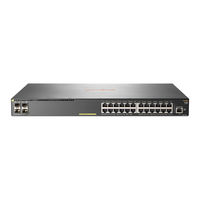HP Aruba 2930F Series Manuals
Manuals and User Guides for HP Aruba 2930F Series. We have 1 HP Aruba 2930F Series manual available for free PDF download: Management And Configuration Manual
HP Aruba 2930F Series Management And Configuration Manual (775 pages)
for ArubaOS-Switch 16.08
Table of Contents
-
-
-
-
Requirements42
-
-
Commands50
-
Timesync Ntp50
-
-
-
Ntp50
-
[No] Ntp50
-
Ntp Enable51
-
Ntp Server53
-
Debug Ntp56
-
Ntp Trap56
-
-
-
-
-
-
-
Usb-Port104
-
Show Usb-Port104
-
-
-
-
-
Poe Terminology106
-
-
Poe Operation107
-
802.3Bt Support122
-
802.3Bt Support123
-
Recommendations125
-
Show Commands125
-
-
-
-
Fault Tolerance130
-
-
-
-
Limitations142
-
-
-
Rate-Limiting153
-
-
-
Operating Notes164
-
-
Jumbo Frames173
-
Operating Rules173
-
Troubleshooting178
-
-
Fault Finder178
-
-
-
-
-
Enabling Snmpv3186
-
Snmpv3 Users187
-
-
Overview196
-
Snmpv2C Informs198
-
Lldp218
-
-
Lldp-Med218
-
-
-
Debug Logging221
-
-
Port Trunking222
-
802.1X Blocking223
-
-
SNMP Support232
-
Neighbor Maximum247
-
Mandatory Tlvs248
-
Overview255
-
Commands255
-
Show Commands256
-
-
-
-
Overview257
-
IP Pools257
-
DHCP Options257
-
Bootp Support257
-
-
Dhcpv4 Server259
-
Dhcp-Server259
-
-
-
Dhcp-Server Pool259
-
Authoritative261
-
-
-
Bootfile-Name261
-
-
-
Default-Router261
-
-
DNS IP Servers261
-
Dns-Server262
-
-
-
Domain-Name262
-
-
-
Lease262
-
-
Subnet and Mask263
-
Network263
-
-
IP Address Range265
-
Range265
-
-
Static Bindings265
-
Static-Bind265
-
-
-
Tftp-Server266
-
-
-
Dhcp-Server Ping266
-
-
-
Dhcp-Server268
-
-
Clear Commands268
-
-
Show Commands269
-
Show Dhcp-Server269
-
-
Event Log270
-
-
-
-
Dhcpv6-Snooping273
-
-
-
Dhcpv6 Event Log287
-
-
ZTP with Airwave293
-
Limitations309
-
Best Practices309
-
-
Amp-Server310
-
Debug Ztp312
-
-
Stacking Support312
-
Ztp312
-
Image Upgrade313
-
Troubleshooting313
-
-
Overview314
-
-
Aruba-Vpn Type319
-
-
Show Commands320
-
-
-
Troubleshooting331
-
Stacking Support335
-
-
Proxy Server342
-
-
-
Overview344
-
-
-
Copy Command-Log357
-
Copy Event-Log357
-
-
-
Usb369
-
Usb-Port369
-
Show Usb-Port369
-
-
Prerequisites370
-
-
-
Copy Flash Usb370
-
-
-
-
-
Overview373
-
-
Show System374
-
-
Task-Monitor Cpu378
-
-
-
Show Management379
-
-
-
Show Modules379
-
-
Port Status385
-
-
-
Allow-V1-Modules392
-
-
Port Status393
-
IP IGMP Status402
-
Show Ip Igmp402
-
-
VLAN Information404
-
Show Vlan404
-
-
Mirror Remote Ip408
-
-
-
Mirror Port408
-
-
-
Interface408
-
Monitor All408
-
Service-Policy409
-
-
-
Mirror Endpoint409
-
-
-
Mirror Remote Ip409
-
-
-
-
-
Fans449
-
-
-
Overview458
-
-
General Problems460
-
-
-
-
Event Log470
-
Fan Failure474
-
-
Event Log478
-
Restrictions478
-
-
-
Using the CLI500
-
-
Debug Command517
-
Debug Messages517
-
-
Logging Command520
-
Diagnostic Tools527
-
-
DNS Resolver544
-
-
-
Job Scheduler551
-
Commands551
-
Show Job552
-
Show Job <Name552
-
-
-
Overview554
-
Use Cases554
-
-
Cfg-Backup558
-
-
-
Cfg-Restore560
-
-
-
Show Hash574
-
-
-
-
-
Debug Security578
-
-
-
Diagnostic Table582
-
Validation Rules583
-
FPS Error Log583
-
-
Overview586
-
How IP SLA Works588
-
-
[No] Ip-Sla <ID588
-
-
Show Commands593
-
Validation Rules601
-
Interoperability604
-
-
Overview604
-
SLA Measurements606
-
-
-
-
Overview608
-
Use Cases609
-
Colorless Ports612
-
-
How It Works621
-
Dependencies623
-
PAPI Security638
-
-
Limitations646
-
-
Overview of VSF648
-
Benefits of VSF650
-
VSF Domain ID651
-
VSF Link651
-
VSF Member ID651
-
VSF Member Roles652
-
Member Priority652
-
VSF Split655
-
VSF Merge655
-
VSF Commands655
-
-
Vsf Disable656
-
Vsf Enable656
-
Vsf Member Link656
-
Vsf Domain657
-
Vsf Member657
-
Vsf Member Type659
-
Vsf Port-Speed660
-
Vsf Vlan-Mad661
-
-
Show Commands662
-
Show Vsf662
-
Show Vsf Detail662
-
Show Vsf Link665
-
Show Vsf Member669
-
Show Cpu675
-
Show System Fans682
-
Show Uptime685
-
-
Support Commands685
-
Copy Core-Dump686
-
Copy Crash-Log686
-
Copy Fdr-Log686
-
Copy Crash-Data687
-
Core-Dump687
-
Copy Crash-Files688
-
-
Port Speed701
-
-
VSF Port Leds702
-
VSF Restrictions706
-
VSF Use Cases706
-
-
-
Overview713
-
Requirements728
-
Limitations728
-
Troubleshooting730
-
-
-
OOBM Concepts732
-
Example733
-
-
-
-
Introduction752
-
CLI Commands756
-
Show Commands760
-
Event Logging761
-
-
-
Speed-Duplex769
-
Glossary
774
Advertisement
Advertisement
